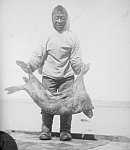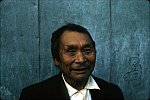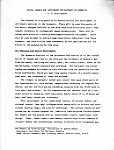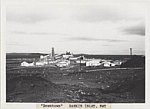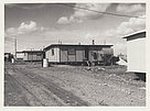Human Adaptation in the Arctic Environment
Author: Curt McManus Page 1 | Page 2 | Page 3
The Pacific coast natives, according to Ken Coates, also had well-developed class-systems and, because of the leisure time afforded to them by the gentler climate, they were also able to develop greater artistic and technical skills.
Many Innu communities in the central and eastern arctic, as already suggested, separated themselves into groups of ten or twelve families. It was the smallness of these communities which enabled them to be highly mobile and interdependent on each other. But perhaps most importantly, by separating they avoided over-hunting.
This matter of separating into smaller communities, however, depended entirely on resource availability. The Dene in the Mackenzie River Basin, for example, lived in a lush environment compared to the Innu of the eastern arctic. The Dene had readily available stocks of game and other resources which enabled them to establish communities that were more permanent in nature. Year-round Dene settlements were not uncommon.
In order to off-set the sometimes meager resources, many native groups assembled each year to engage in trade. Like the plains natives, the Dene and Inuit would often exchange goods and trade within their own sub-groups at pre-arranged locations each year.
Life in the Arctic was not easy, and hardship was certainly not unknown. But the natives of the Canadian North lived for hundreds of years absent any form of contact with other peoples and nations solely by their ability to adapt to arctic life. Their continued existence is a testament to the success of their adaptability.
The lives of the northern natives, however, like their southern counterparts, would never be the same after the 19th century. Explorers like Captain John Ross continued fumbling with the North West Passage. And the Hudson’s Bay Company had at long last found the Canadian North and so slowly expanded and developed numerous fur trade posts in the region: by the 1950’s there were some 70 posts across the Canadian arctic. Exploration, the fur trade, and the Gold Rush; all were elements which altered and changed the northern native way of life and ended the long isolation of the region from the outside world. But, for all these changes which occurred in the 19th century, the Fur Trade had the greatest impact.
The operation of the northern fur trade mirrors almost exactly the fur trade in the south. Natives would meet at trading posts once or twice a year, conduct elaborate ceremonies, exchange gifts and then engage in trade. Northern natives in the late 19th and early 20th centuries also began altering the ways in which they had formerly adapted to their environment. For example, some Innu and Dene settled permanently at the new fur trading posts established by the Hudson’s Bay Company and became known as home-guards” or “post” Indians. This change in settlement patterns had an obvious impact on the traditional Innu community units.

Fort Providence at the height of the Fur Trade in the Canadian North, 1928.
Fort Providence was located on the western shores of Great Slave Lake.
Another way in which Native life changed was over-hunting. Innu and Dene had long recognized the importance of husbanding their resources; Innu community units were designed around the recognition of the dangers of over-hunting. However, given the luxuries and new necessities the natives received through the trade in furs, over-hunting became more and more common because hunting became less and less about simple existence. Historian Ken Coates noted that hunting became an activity connected to foreign economies and was also tied to the provisioning of trading forts. In short, by 1850, hunting was no longer something the Innu and Dene did solely to survive in the arctic.
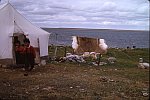
Drying Caribou hide at Eskimo Point NWT.
Despite changes, traditional ways of hunting did not change for many.
There were other dramatic changes to which the northern natives were subject. Innu women married fur traders and so once more the traditional community unit was affected. Missionaries also flooded the north in a battle to save the souls of the natives in advance of the encroachment of European civilization. In short, as historian Ken Coates notes, “the restructuring of the north had begun” and it would never be the same.
The changes experienced by the Natives were noted, with characteristic harshness, by a Hudson’s Bay Company official. F.H. Kitt said “no longer are they ignorant savages dwelling in igloos in winter and forced to eke out a pitiful existence in a terrific struggle against all forces of nature” but rather the Innu and Dene had grown accustomed to luxuries. Kitt noted that butter, jam, flour, sugar, canned food, radios, sewing machines and rifles were all goods commonly used by natives as early as 1910. But this seemingly innocuous list of luxuries contained some serious implications.
R.G. Williamson noted that the rifle, for example, forever changed traditional hunting patterns and methods and allowed Innu to hunt alone or in groups of two. Ken Coates explains that the Innu welcomed these changes to their lives, and adapted these new technologies to their arctic existence. They adapted as they had always adapted. But the question remains, “at what cost?” Historian Morris Zaslow says by the middle of the 20th century, “tastes had changed and old skills had atrophied.”
Today, the old skills and tastes which for centuries had underpinned native survival in the Canadian north are no longer required. In less than one hundred years, from roughly 1850 to 1950, a centuries old way of life had disappeared. HBC stores now provide many of the necessities needed for daily life in the north. Changes such as this have eliminated the need for small community-based groups organized around hunting. More to the point, after hundreds years of learning to adapt to their environment, northern natives no longer need those same skills.
It seems as though the basic skills required to survive in the arctic have also fallen into disrepair. For example, having to survive in arctic conditions is now something taught at school.
Satisfying physical comforts, however, has not entirely eliminated the need to adapt. The use of the word “adaptation” is a way to express the process by which northern natives overcame the hazards and difficulties associated with living in the arctic. Where northern natives previously fought to overcome and adapt to the physical environment in which they lived, today, that effort is directed toward overcoming and adapting to new political challenges.
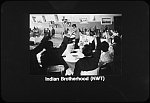
An early example of political activism in the Canadian North. A meeting of the NWT Indian Brotherhood, Fort Rae, 1970.
The Indian Brotherhood pictured, was initially formed in 1970 in order to fight the hastily arranged treaties signed between federal authorities and the Indians of the Mackenzie River Basin in the late 19th and early 20th centuries. The treaties were signed shortly after the Klondike Gold Rush and in advance of expected resource development in the Mackenzie region.
The Indian Brotherhood was one of the first expressions of growing northern native political consciousness. They were also the precursor to later groups who, for example, wrote the Dene Declaration of 1975. This document was developed in response to increased intrusions in the Mackenzie River area by oil and gas companies without the consent of the Dene. The manifesto reads in part: “We the Dene of the North West Territories insist on the right to be regarded by ourselves and the world as a nation... the government of Canada is not the government of the Dene. The government of the NWT is not the government of the Dene... There are realities we are forced to submit to such as the existence of a country called Canada [but] we insist on the right to self-determination as a people.”
The Canadian North has been many things to many people. To Captain Ross, it was a frozen wasteland cut off from the outside world; to the Stampeders of the Gold Rush era, the north represented a way to get rich quick; to oil and gas companies, the north was an under-developed resource rich region; to the federal government it was an area which was often simply forgotten. But for the natives who had lived there for centuries, it was something else. As Historian Ken Coates wrote, “The land was not a foreign environment to be conquered; it was instead their universe, a constellation of physical and spiritual elements that defined their existence.” It was home.
